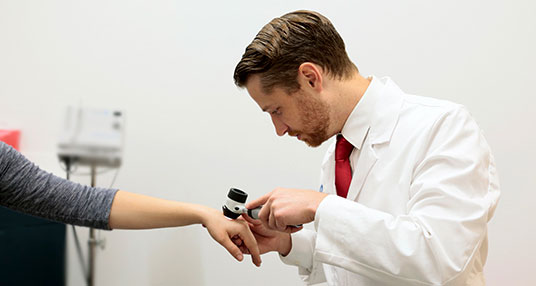
Interested in Mole Removal in Phoenix?
All people have moles. In fact, you probably have more moles than you realize. Fortunately, moles present a very low health risk. This may be why they have not been studied extensively, and the role of genetics in their development is unclear.
What is a Mole?
Moles are an overgrowth of cells. They occur when pigment-producing cells called melanocytes grow in a cluster rather than being spread out over the skin. Usually light brown to black in color, and less than a quarter inch in diameter, moles can occur anywhere on the body.
Generally, moles will develop during childhood and adolescence, changing in size and color as a person ages. They emerge less commonly after age 25, but by adulthood it is normal to have multiple moles, even up to 30 or 40. As with freckles, fair-skinned people tend to have more moles than other skin types. Moreover, moles seem to run in families, with similar numbers of moles occurring on members in different generations.
Most moles are benign (not cancerous). Over time, however, mole shapes, sizes, and colors can change. Some moles may even fade or disappear completely. Genetics, age, and sun exposure likely play a role in such changes. In fact, moles almost always appear on parts of the body that are exposed to the sun. Not surprisingly, infants and the elderly tend to have the fewest moles.
New moles commonly emerge as your body experiences changes in hormone levels, as happens during adolescence and pregnancy. However, new moles that appear in adulthood have more of a chance of becoming cancerous than old moles. It is important to pay attention to new moles or changes in your moles. If a mole becomes larger and irregular in shape; changes color; bleeds or becomes infected; becomes raised or rough in texture; or becomes sensitive, itchy, or painful, it’s important to consult a dermatologist immediately. In addition, people with 50 or more moles should have regular skin check-ups so the dermatologist can monitor for potential skin cancer.
Types of Moles?
The clinical term for a mole is nevus (neev-us) or, plural, nevi (neev-eye), a word from Latin meaning “birthmark.” In fact, a birthmark can be considered a kind of mole and is one of three main types of moles: Congenital Moles (Congenital Nevi), Common Moles, and Atypical Moles (Dysplastic Nevi).
Assessing Atypical Moles—the ABCDEs of Melanoma
The American Academy of Dermatology offers the following ABCDE guide to identifying potentially cancerous moles. If you have a mole that shows any of the signs described below, you should consult a dermatologist immediately.
Mole Treatment and Removal
The good news: Most moles do not need to be treated or removed. However, you may consider having a mole removed in the following cases: if it rubs against clothing or is otherwise bothersome, if there is a possibility the mole might be cancerous, or for cosmetic reasons. In any case—and despite advice you might find on the Internet—you should never attempt to remove a mole at home. It is best to let a dermatologist determine what kind of mole it is during a skin screening—and, indeed, if it is a mole and not some other kind of skin growth or melanoma—and advise you on the best course of action.
Saguaro Dermatology Reviews

Itaro Elaisa
“I totally recommend this place to anyone who’s looking for a dermatologist who’s professional, informative, respectful and very helpful. They are quick to solve your problems and get you home.”

Wendy L.
I had an awesome experience with Dr Hamann and staff. I was very comfortable and i was able to have all my questions answered without feeling rushed. The staff was courteous and welcoming.

Robert P.
Staff was friendly, & on time. office is super clean!! Doctor was awesome, felt like a family member taking care of me.

Kristin U
“Dr Dathan and the team were very helpful, kind and knowledgeable. Plus, there was no wait time so I was able to get back to work faster than expected. I would highly recommend.”

Amanda C.
Great doctor and friendly, professional staff. The doctor spends time listening and answering questions, something rare to find anymore. The office is beautiful and very clean. I love all the artwork with saguaros.

Sally S.
“Very friendly and professional. I had a great experience, Dr. Hamann was very good at answering my questions and concerns. I will certainly come back for another visit.”

L
Dr. Hamann is very knowledgeable, nice, and professional. You can tell that he truly cares about his patients by the way he operates. He took the time to listen to all of my concerns then address them with good, well-informed answers.

Kylin L.
“The office was recently renovated–it is a beautiful, clean, and calm environment. I would highly recommend this practice for anyone who is looking for a general dermatologist.”

About Saguaro Dermatology
Our comprehensive dermatology clinic is dedicated to providing you with the highest quality of care, innovative practices, helpful resources and state-of-the-art technology to prevent and treat a multitude of skin disorders. Led by Carsten R. Hamann, MD, PhD, Dathan Hamann, MD, FAAD, Michael McBride, DO, Millard Thaler, MD, Mohs Surgeon and Jenna Wald, MD, Mohs Surgeon, our passionate team looks forward to serving you with respect and compassion.
 Ahwatukee
Ahwatukee




